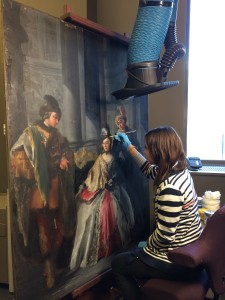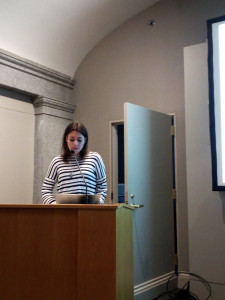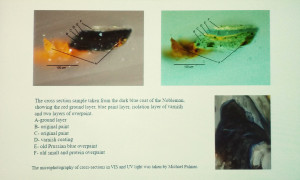Joanna Strombek presented a case study of a painting attributed to Louis Joseph Le Lorrain, oil on canvas, c. 1740(?) from the collection of the National Gallery of Art in Washington. Strombek, a Graduate Intern working at the National Gallery of Art, started by presenting the historical research and scientific analysis she performed to explore the current attribution of the painting. She concluded her presentation by describing the ongoing treatment of the painting.
“Three Figures Dressed for a Masquerade” attributed to Louis-Joseph Le Lorrain, 18th century, is an oil painting on canvas showing three noble figures surrounded by the Roman architecture. The attributed artist was born in Paris. For studies, he moved to Rome and near the end of his life, he spend a year in Russia.
The scientific analysis included examination of the canvas, ground, paint layers, and multiple non-original varnish coatings that covered the surface. The components of the ground detected in the “Three Figures” painting were similar to those found on a signed painting by Le Lorrain in the Musée Fabre collection. Fiber analysis verified that the canvas is composed of hemp fibers, which might help make an argument for the painting’s current attribution and dating.
The painting was relined in the past, and there were no original tacking margins remaining. The surface was very dull and yellowed due to a heavy layer of grime and multiple degraded varnish coatings, which interfered with UV light fluorescence and masked most of the old repairs. However, the UV image showed that in the past, the face of the nobleman on the right was overpainted, changing his features. Another problematic area was located in the nobleman’s dark blue coat, which appeared to be blanched and undersaturated. Scientific examination led to the conclusion that it was an overpaint layer made of smalt mixed in protein binder, which has degraded and strongly faded.
The goal of the treatment was mostly aesthetic, to remove the heavy grime, multiple degraded varnish coatings, and possibly overpaint, in order to regain the original splendor of a painting.
Strombek tested several solvents compositions in liquid and gel forms to remove the grime and varnish coatings, which responded differently to each solution. A mixture of liquid polar organic solvents was used successfully to remove the varnishes and overpaint on the face of a figure. A cross-section taken from the overpainted blue coat showed that although there was an isolating layer of varnish between the original paint and the overpaint, the varnish was too thin to help with overpaint removal. The decision was made to leave it in place rather than take such a risk.
Old fills were partially removed and refilled. Currently losses and abrasions are being inpainted with pigments in aldehyde resin. After retouching is complete, the painting will be sprayed with the multiple layers of aldehyde resin to achieve a final even gloss and saturation.
Summarized by: Claire Valero, Advanced Intern in Paper Conservation at the Library of Congress


